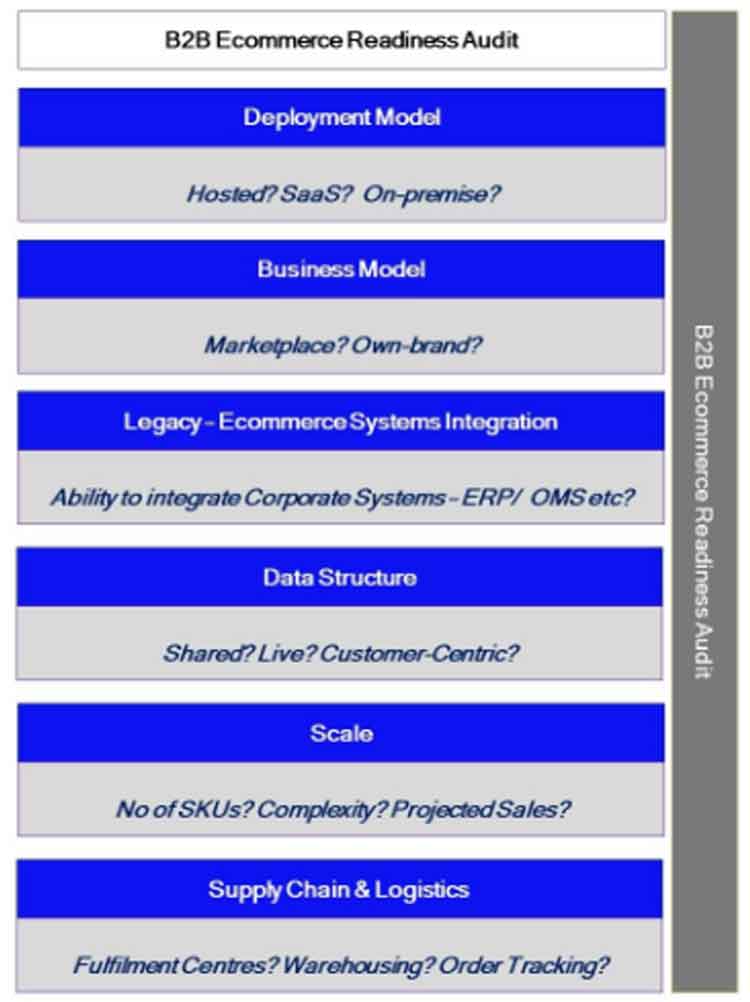
The Critical Questions for all businesses to answer when beginning a B2B Ecommerce Project.
B2B Ecommerce is set to grow exponentially in the next few years. According to Forrester Research, the US B2B eCommerce market in 2020 is expected to be worth $1.1 trillion — twice the size of the US business-to-consumer (B2C) eCommerce market.
However, not all businesses are ready to launch into B2B Ecommerce. Which is why at Aquitude, we have developed our own B2B Ecommerce Readiness Audit.

A company embarking on a B2B Ecommerce journey, needs to score its readiness in the following areas in order to avoid the most common mistakes,
Business Model: B2B Ecommerce has to be underpinned by a thought-out business model. Do you focus on your own brands? Do you sell direct and bypass your existing resellers and distributors? Or will you build a Marketplace, with multiple, even, competing brands? Each of these different business models, have different cost structures, opportunities and challenges.
Deployment Model: The benefits of ‘The Cloud’ have been taken advantage of by many companies, but often, regulated industries such as healthcare, require specific hosting in a set location or in-country. These requirements impact whether you opt for a hosted or Software as a Service (SaaS) solution.
Data Structure: Data management and data structures has a big impact on E-commerce deployment. Is the Data in your organisation shared among all the relevant departments, or is it siloed? How often does your data on customers and your overall business get refreshed? Or, better yet, is it live? Critically, how far is your Customer data set giving you a 360-degree view of customers’ orders, payment terms etc?
Scale: The number of Stock Keeping Units (SKUs) to be sold via ecommerce has an impact both from a systems and a user experience perspective. How complex are the products? Do they require special add-ons, such as After-Sales-Service? What impact does this have on search? Do you need a Product Information Management (PIM) system to manage content related to your catalog, including user manuals and technical documents? What is the scale of the ecommerce operation at its full projected capacity?
Supply-chain & Logistics: To allow highly accurate delivery of the right items to either B2B and B2C customers, technology needs to seamlessly integrate all aspects of an e-commerce operation. The ‘shopping cart’ needs to be connected to the transport system to ensure that shipping costs and time frames communicated to the customer are accurate and updated.
The supply-chain management of ecommerce operations is complex and includes the following areas which need to be addressed:
– Warehousing and E-Fulfillment Considerations: Order Auditing; Proper Packaging: Accurate Inventory Management.
– Delivery Strategy: Shipping Considerations and underlying costs e.g. Free Shipping vs Flat Rates.
– Shipping Modes: e.g. Ship to Home/Office/Site vs Ship to Store.
– Reverse Logistics: when a product is returned to the seller, a number of complex policies and frameworks have to be in place such as: Returns Policy; Returns Preparation; Returned Item Reception; Refund / Credit processes; Return item inspection and sorting; Asset Recovery System (which could include things such as restocking, repackaging for sale, return to a vendor and disposal or scrapping).
Our B2B Ecommerce Readiness Audit acts as the foundation for developing an integrated B2B ecommerce strategy. Let us guide you through these critical, and often complex, steps.
Next Steps
- Get in Touch. Let’s have a Zoom call to understand your B2B ecommerce goals
- Buy the Book. The Ingredients for B2B Ecommerce Success expands on the ideas listed above and gives insight into how to deliver return on investment in ecommerce projects.